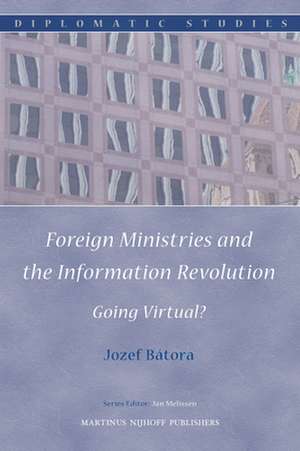Foreign Ministries and the Information Revolution: Going Virtual?: Diplomatic Studies, cartea 2
Autor Jozef Bátoraen Limba Engleză Hardback – 24 iul 2008
Din seria Diplomatic Studies
- 18%
 Preț: 987.37 lei
Preț: 987.37 lei - 18%
 Preț: 838.59 lei
Preț: 838.59 lei - 18%
 Preț: 872.96 lei
Preț: 872.96 lei - 18%
 Preț: 818.02 lei
Preț: 818.02 lei - 18%
 Preț: 823.96 lei
Preț: 823.96 lei - 18%
 Preț: 784.10 lei
Preț: 784.10 lei - 18%
 Preț: 798.29 lei
Preț: 798.29 lei - 18%
 Preț: 778.52 lei
Preț: 778.52 lei - 18%
 Preț: 630.20 lei
Preț: 630.20 lei - 15%
 Preț: 463.50 lei
Preț: 463.50 lei - 18%
 Preț: 724.13 lei
Preț: 724.13 lei - 15%
 Preț: 513.33 lei
Preț: 513.33 lei - 18%
 Preț: 843.53 lei
Preț: 843.53 lei - 18%
 Preț: 613.78 lei
Preț: 613.78 lei - 18%
 Preț: 833.26 lei
Preț: 833.26 lei - 18%
 Preț: 764.32 lei
Preț: 764.32 lei - 18%
 Preț: 817.18 lei
Preț: 817.18 lei - 18%
 Preț: 694.47 lei
Preț: 694.47 lei - 18%
 Preț: 630.84 lei
Preț: 630.84 lei
Preț: 740.78 lei
Preț vechi: 903.38 lei
-18% Nou
Puncte Express: 1111
Preț estimativ în valută:
141.75€ • 151.58$ • 118.19£
141.75€ • 151.58$ • 118.19£
Carte indisponibilă temporar
Doresc să fiu notificat când acest titlu va fi disponibil:
Se trimite...
Preluare comenzi: 021 569.72.76
Specificații
ISBN-13: 9789004169005
ISBN-10: 9004169008
Pagini: 250
Dimensiuni: 160 x 244 x 18 mm
Greutate: 0.57 kg
Editura: Brill
Colecția Brill | Nijhoff
Seria Diplomatic Studies
ISBN-10: 9004169008
Pagini: 250
Dimensiuni: 160 x 244 x 18 mm
Greutate: 0.57 kg
Editura: Brill
Colecția Brill | Nijhoff
Seria Diplomatic Studies
Cuprins
Chapter 1: INTRODUCTION
IT-revolution and diplomacy
Institutional resilience of diplomacy
IT-revolution or institutional resilience?
Organization of chapters
Chapter 2: THE ORGANIZATIONAL BASIS OF MODERN DIPLOMACY:
ITS EMERGENCE, CHARACTERISTICS AND CHANGE
2.1 Introduction
2.2 The ‘informational prerogative’ of the state and the organizing principles of modern diplomacy
2.3 Diplomacy as an institution of the interstate order
2.4 Conclusion
Chapter 3: ANALYZING IT-EFFECTS IN FOREIGN MINISTRIES
3.1 Introduction
3.2 Foreign ministries and the information revolution(s)
3.3 IT and institutional change dynamics
3.3.1 IT-enabled institutional transformation
3.4 Operationalizing the core organizing principles of diplomacy
3.5 Multiple scenarios of IT-effects on the organizational basis of diplomacy
3.6 Methodology
3.7 Conclusion
Chapter 4: DEPARTMENT OF FOREIGN AFFAIRS AND INTERNATIONAL TRADE
4.1 Introduction
4.2 Institutional background and characteristics of DFAIT
4.3 IT-infrastructure of DFAIT
4.4 IT-effects on hierarchy
4.5 IT-effects on secrecy
4.6 IT-effects on communication with the public
4.6.2 Level of centralization of communication with the public
4.7 Conclusion
Chapter 5: ROYAL NORWEGIAN MINISTRY OF FOREIGN AFFAIRS
5.1 Introduction
5.2 Institutional background and characteristics of N-MFA
5.3 IT-infrastructure of N-MFA
5.4 IT-effects on hierarchy
5.5 IT-effects on secrecy
5.6 IT-effects on communication with the public
5.7 Conclusion
Chapter 6
MINISTRY OF FOREIGN AFFAIRS OF THE SLOVAK REPUBLIC
6.1 Introduction
6.2 Institutional background and characteristics of MFASR
6.3 IT-infrastructure of MFASR
6.4 IT-effects on hierarchy
6.5 IT-effects on secrecy
6.6 IT-effects on communication with the public
6.7 Conclusion
Chapter 7: CONCLUSION: THE ORGANIZATIONAL BASIS OF DIPLOMACY RENEWED
7.1 Introduction
7.2 IT-effects on the core organizing principles of diplomacy: the main findings
7.2.3 IT-effects on communication with the public
7.2.4 Additional observations and findings
7.3 What were the drivers of change?
7.4 Theoretical observations
7.5. Revolution ante portas?
References
Appendixes
IT-revolution and diplomacy
Institutional resilience of diplomacy
IT-revolution or institutional resilience?
Organization of chapters
Chapter 2: THE ORGANIZATIONAL BASIS OF MODERN DIPLOMACY:
ITS EMERGENCE, CHARACTERISTICS AND CHANGE
2.1 Introduction
2.2 The ‘informational prerogative’ of the state and the organizing principles of modern diplomacy
2.3 Diplomacy as an institution of the interstate order
2.4 Conclusion
Chapter 3: ANALYZING IT-EFFECTS IN FOREIGN MINISTRIES
3.1 Introduction
3.2 Foreign ministries and the information revolution(s)
3.3 IT and institutional change dynamics
3.3.1 IT-enabled institutional transformation
3.4 Operationalizing the core organizing principles of diplomacy
3.5 Multiple scenarios of IT-effects on the organizational basis of diplomacy
3.6 Methodology
3.7 Conclusion
Chapter 4: DEPARTMENT OF FOREIGN AFFAIRS AND INTERNATIONAL TRADE
4.1 Introduction
4.2 Institutional background and characteristics of DFAIT
4.3 IT-infrastructure of DFAIT
4.4 IT-effects on hierarchy
4.5 IT-effects on secrecy
4.6 IT-effects on communication with the public
4.6.2 Level of centralization of communication with the public
4.7 Conclusion
Chapter 5: ROYAL NORWEGIAN MINISTRY OF FOREIGN AFFAIRS
5.1 Introduction
5.2 Institutional background and characteristics of N-MFA
5.3 IT-infrastructure of N-MFA
5.4 IT-effects on hierarchy
5.5 IT-effects on secrecy
5.6 IT-effects on communication with the public
5.7 Conclusion
Chapter 6
MINISTRY OF FOREIGN AFFAIRS OF THE SLOVAK REPUBLIC
6.1 Introduction
6.2 Institutional background and characteristics of MFASR
6.3 IT-infrastructure of MFASR
6.4 IT-effects on hierarchy
6.5 IT-effects on secrecy
6.6 IT-effects on communication with the public
6.7 Conclusion
Chapter 7: CONCLUSION: THE ORGANIZATIONAL BASIS OF DIPLOMACY RENEWED
7.1 Introduction
7.2 IT-effects on the core organizing principles of diplomacy: the main findings
7.2.3 IT-effects on communication with the public
7.2.4 Additional observations and findings
7.3 What were the drivers of change?
7.4 Theoretical observations
7.5. Revolution ante portas?
References
Appendixes
Notă biografică
Jozef Bátora, PhD. (2006) in Political Science, University of Oslo, is Research Fellow at the Institute for European Integration Research, Austrian Academy of Sciences in Vienna.
